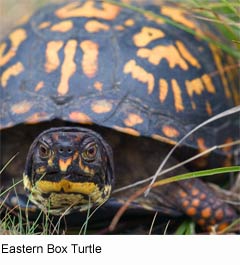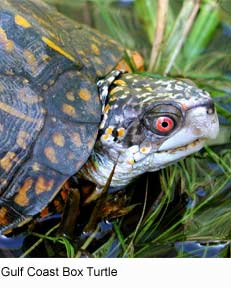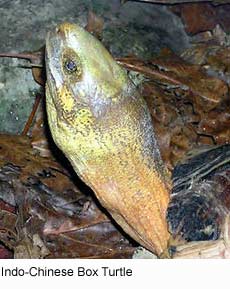
A Hinge-shelled Turtle: The Eastern Box Turtle (Terrapene carolina carolina) is a subspecies within a group of hinge-shelled turtles, normally called Box turtles. T. c. carolina is native to an eastern part of the United States. Occasionally, it is referred to as the Common Box Turtle to distinguish it from the other five subspecies of Eastern box turtles.
 Shell of Many Colors: Eastern box turtles have a high, dome-like shell and a hinged plastron that allows total shell closure. Shell of Many Colors: Eastern box turtles have a high, dome-like shell and a hinged plastron that allows total shell closure.
The carapace can be of variable coloration, but is normally found brownish or black and is accompanied by a yellowish or orangish radiating pattern of lines, spots or blotches. Skin coloration, like that of the shell, is variable, but is usually brown with some yellow, orange, or white spots or streaks.
The color of the shell and skin of an Eastern box turtle differs with age; younger turtles of the type are often more vibrantly colored than the older. Furthermore, males normally possess red eyes (irises) as females display brown eyes more often than not. Eastern box turtles feature a horny beak, chubby limbs, and their feet are webbed only at the base.
Weights and Measures: Staying small in size, males grow to up to 7", and females to about 8". In the wild, box turtles are known to live over 80 years, but in captivity, usually live only between 30-50.
 Where in the World? The Eastern box turtle is found mainly in the eastern United States, as is implied by its name. They are populated as far north as southern Maine and the northwest of the Michigan Lower Peninsula, south to southern Florida and west to eastern Kansas, Oklahoma, and Texas. The Eastern box turtle is considered uncommon to rare in the Great Lakes region; however, populations can be found in areas not bisected by heavily traveled roads. In the Midwest, they are a species of Special Interest in Ohio, and of Special Concern in Michigan. Where in the World? The Eastern box turtle is found mainly in the eastern United States, as is implied by its name. They are populated as far north as southern Maine and the northwest of the Michigan Lower Peninsula, south to southern Florida and west to eastern Kansas, Oklahoma, and Texas. The Eastern box turtle is considered uncommon to rare in the Great Lakes region; however, populations can be found in areas not bisected by heavily traveled roads. In the Midwest, they are a species of Special Interest in Ohio, and of Special Concern in Michigan.
Eastern box turtles prefer deciduous or mixed forested regions, with a moderately moist forest floor that has good drainage. They can be also found in open grasslands, or pastures.
On the Menu: The eating habits of Eastern box turtles vary greatly due to individual taste, temperature, lighting, and their surrounding environment. As is different from warm-blooded animals, their metabolism doesn't force their eating, rather they can just lessen their activity level, retreat into their shells and halt their food intake until better conditions arise.
 Not Picky: There are a variety of foods which are universally accepted by Eastern box turtles, which include earthworms, snails, grubs, beetles, caterpillars, grasses, fallen fruit, berries, mushrooms, flowers, and carrion. Many times, they will eat an item of food, especially in captivity, just because it looks and smells edible, such as hamburger or eggs. Not Picky: There are a variety of foods which are universally accepted by Eastern box turtles, which include earthworms, snails, grubs, beetles, caterpillars, grasses, fallen fruit, berries, mushrooms, flowers, and carrion. Many times, they will eat an item of food, especially in captivity, just because it looks and smells edible, such as hamburger or eggs.
Pets on Plates: Thousands of box turtles are collected from the wild every year for the exotic pet trade, and some are even shipped to Asia for the food market. Captive breeding is fairly commonplace, but not so much that it can supply the market demand.
Box turtles can make hardy captives if their needs are met, and are frequently kept as pets. They are also well represented in many zoos throughout the world.
All text is available under the terms
of the GNU Free Documentation License
|